[Important update: we have learnt that there were errors in one of the source data we used in the paper that this blog is based on. They weren’t our errors but their presence undermined our confidence in the findings of the paper. Accordingly, we have retracted the paper. We have replaced it with a new paper that draws on new and more reliable data. You can find a blog post on the new paper here. As we completed the new paper we found similar, but not identical, findings to those in the original paper. For transparency’s sake we have left this blog post in place below. But we do not recommend you draw on the findings it reports. Rather, read the new paper.]
When they are surveyed, Australians appear to be supportive of aid work. A poll from 2009 [pdf] found, for example, that 86 per cent were in favour of the Australian government giving foreign aid. Yet beyond the presence of nominal, high-level support, little is known about the nature of their support for aid, or the types of Australian most favourable to giving. Are aid’s supporters predominantly wealthy? Or religious? Or educated? Or young? And is support coupled with particular political or ideological beliefs? Even less is known about the depth of the Australian public’s commitments to aid giving — the extent to which people are actually willing to support aid work when it comes at a cost.
It is these questions that we attempt to answer in the latest Devpolicy Discussion Paper. In the paper we combine two new datasets to learn more about Australians’ support for ODA (at the electorate level) alongside their actual private donations.
The first dataset is based on results from the Vote Compass survey run in conjunction with the 2013 Australian elections. The Vote Compass team provided us with the results for each electorate to the question “Australia should spend more on foreign aid” (available interactively here). Results were weighted to make them representative of the population. While the question isn’t perfect, it still allows us to make comparisons of levels of support between Australian electorates.
The second dataset focuses on the proportion of each electorate that made donations to a group of large Australian aid NGOs. Data was collected by ACFID, which we gathered from their website. This dataset is interesting as a gauge of the depth of opinion. It’s one thing to click a button on a website expressing your support for aid, but giving directly to an NGO involves a direct sacrifice, and therefore reflects depth of support. Obviously, the NGO data is also interesting for what it can tell us about the practicalities of NGO support.
Our paper combines these datasets with socio-economic data from the census and election results (to capture political preferences). We then used regressions to look at socio-economic and political determinants of support for ODA and NGO aid, and to test whether expressed support for ODA is actually correlated to actual NGO donations.
A cursory glance at the data shows us that Australia is far from homogenous in its support for ODA or its giving to NGOs. For example, the chart below shows the proportion of five Australian electorates (including the highest and lowest extremes) who gave to aid NGOs in 2012. We see similar variance, albeit of slightly smaller magnitude, in surveyed support for ODA too.
Variance in proportion of electorate giving to aid NGOs
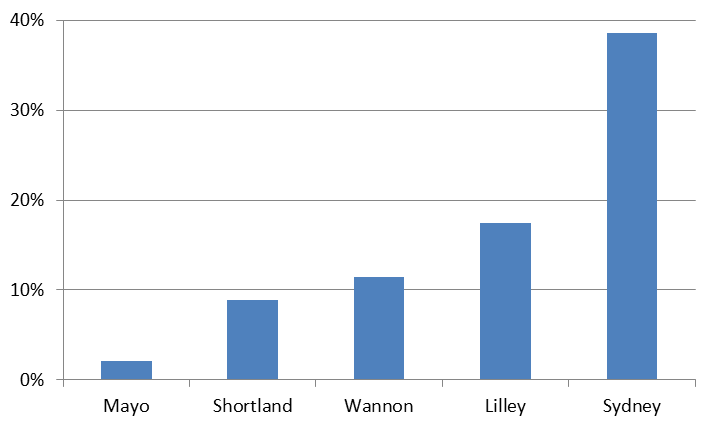 Note: Mayo and Sydney are the outliers in the dataset. The electorate average is 14%.
Note: Mayo and Sydney are the outliers in the dataset. The electorate average is 14%.
You can also view the datasets interactively:
Note: Average support for ODA ranges between 2.229 and 3.364. You can alternate between ‘support for ODA’ and ‘proportion of electorate donating to aid NGOs’ by clicking on the ‘visible layers’ legend.
Support for ODA
We started by looking at the effect of wealth on support for government ODA. The chart below is a simple bivariate analysis that maps support for ODA against the proportion of the population earning over the median income. From the chart we can see a reasonably clear bivariate correlation: on average, wealthier electorates are home to more supporters of government ODA.
Income and support for ODA
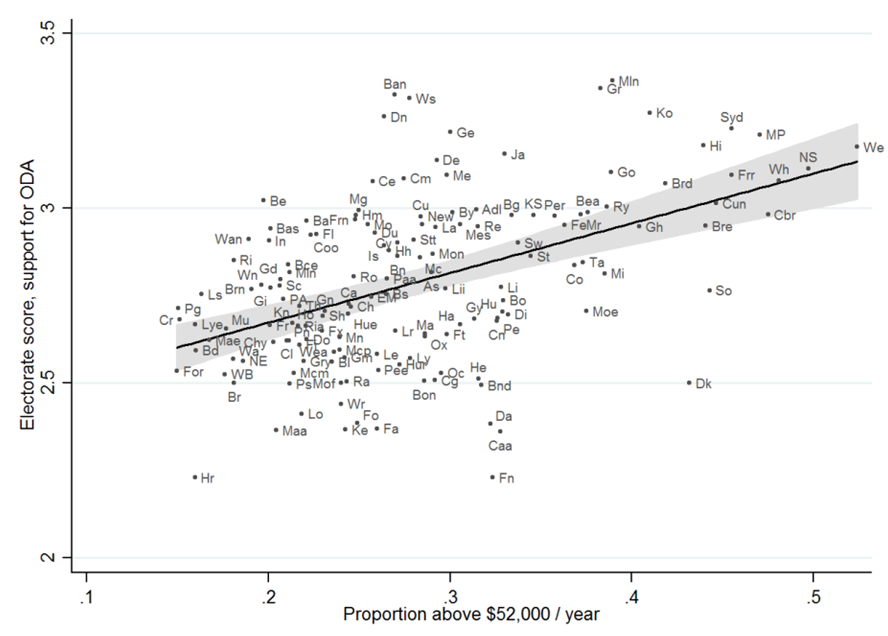 Note: Support for ODA is measured on a scale of 1 to 5 (1 being least supportive, 5 being most supportive). Regression results can be found in the discussion paper.
Note: Support for ODA is measured on a scale of 1 to 5 (1 being least supportive, 5 being most supportive). Regression results can be found in the discussion paper.
While the above is useful to know, it does not in itself explain support for ODA, since wealth is also correlated with other socio-economic factors, which may themselves be correlated both with income and ODA. Indeed, when we ran multiple regressions to control for this, we found education to be the variable most strongly correlated with support for ODA. When education’s effect is controlled, our results actually show that wealth’s direct impact on support for ODA is negative. Surprisingly, at the electorate level, religiosity also has a negative impact on support for ODA. Age and urbanisation, the two other variables we tested for, appear to have no discernible impact.
Turning to the impact of political preference on support for ODA, our results find a strong positive correlation between Greens support and support for ODA, with weaker positive and negative association for Labor and the Coalition respectively. The magnitude of this influence can be seen in the chart below. It shows on the Y axis, on the basis of our results, the increase in the average electorate level support for ODA score we would expect to see if education in an electorate doubled (while other variables stayed the same).
Magnitude of influence of political preference on support for ODA
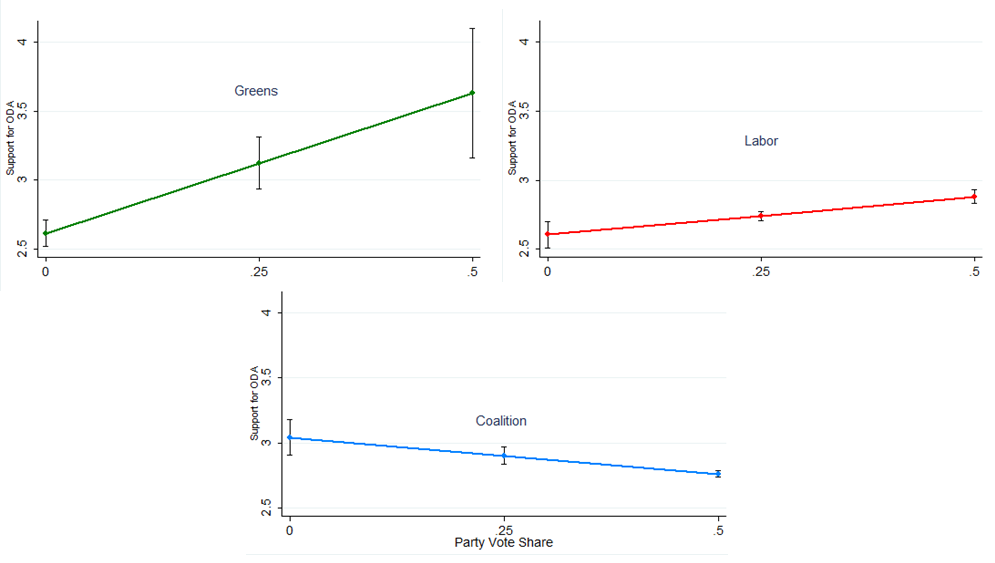 Note: Support for ODA is measured on a scale of 1 to 5 (1 being least supportive, 5 being most supportive). Party vote share is the proportion of an electorate listing each party as their ‘first preference’ in the 2013 Federal election.
Note: Support for ODA is measured on a scale of 1 to 5 (1 being least supportive, 5 being most supportive). Party vote share is the proportion of an electorate listing each party as their ‘first preference’ in the 2013 Federal election.
NGO donations
When we paired out survey data on support for ODA with our data on NGOs, we found a clear correlation at the electorate level between ODA support and NGO donations. Electorates where support for ODA is high are also electorates where higher proportions of the population give to NGOs. So, to answer the title of our blog post, it appears that, by and large, Australians do indeed put their money where their mouths are.
Support for ODA and donations to NGOs
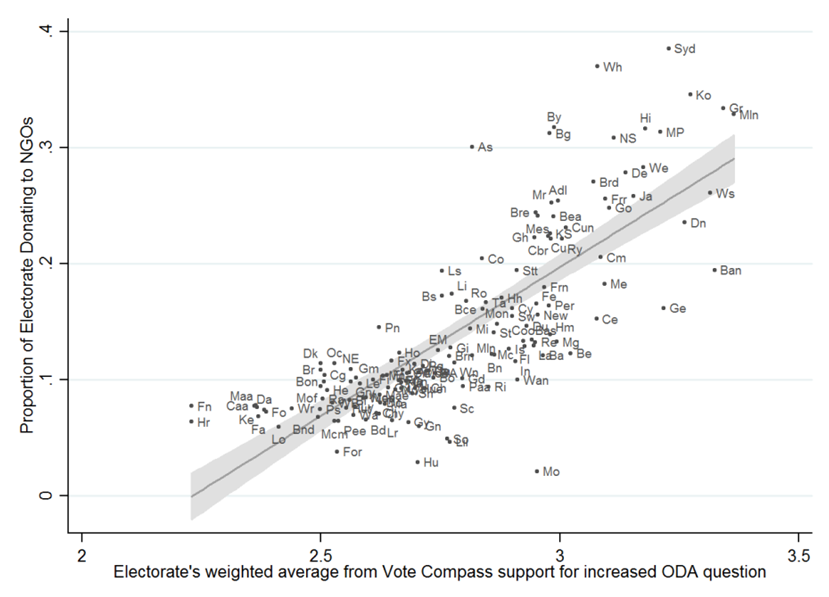 Reflecting this, we see similar results when looking at the determinants of donations to aid NGOs. Levels of education are again the key determinant of giving and, once this is controlled for income, has no significant impact while religion is again negatively correlated. There is also a strong positive relationship between Greens support and donations to NGOS. However, in the case of NGO donations, there is no statistically significant relationship between support for Labor or support for the Coalition and giving to NGOs.
Reflecting this, we see similar results when looking at the determinants of donations to aid NGOs. Levels of education are again the key determinant of giving and, once this is controlled for income, has no significant impact while religion is again negatively correlated. There is also a strong positive relationship between Greens support and donations to NGOS. However, in the case of NGO donations, there is no statistically significant relationship between support for Labor or support for the Coalition and giving to NGOs.
Summing up
Our research shows that, above all, levels of tertiary education are the strongest predictors of support both for ODA and actual NGOs donations. Greens party support is also a relatively strong predictor for both. A summary of the rest of our results can be found in the table below.
These results are only the start of a rich field of further research. Our study has been aggregated at the level of the electorate, not the individual, which could be done through surveys. We also don’t know much about the causal pathways present in the relationships above – why does tertiary education lead to more support for aid and NGOs? In future studies we plan to disaggregate combined groups, such as ‘religious’, to see if the effect we have found is driven by particular churches or other groups. We also plan to undertake experimental work on different ways of framing aid questions to see if they change or don’t change levels of support.
There is certainly more to be done, but we are off to a good start. Our research fills a void in empirical analysis on perceptions in Australian aid, and may also even have some practical utility: knowing where and who supports aid offers a sense of where to target fundraising endeavours and campaigning.
This research was presented in a public lecture at the ANU in early August. More details, including a podcast of the event and presentation slides, are available here.
Terence Wood is a Research Fellow at the Australian National University and Research Officer at the Development Policy Centre. Alex Cifuentes was an intern at the Development Policy Centre in Semester 1 2014. Jonathan Pryke is a Research Officer at the Development Policy Centre.
[Important update: we have learnt that there were errors in one of the source data we used in the paper that this blog is based on. They weren’t our errors but their presence undermined our confidence in the findings of the paper. Accordingly, we have retracted the paper. We have replaced it with a new paper that draws on new and more reliable data. You can find a blog post on the new paper here. As we completed the new paper we found similar, but not identical, findings to those in the original paper. For transparency’s sake we have left this blog post in place below. But we do not recommend you draw on the findings it reports. Rather, read the new paper.]

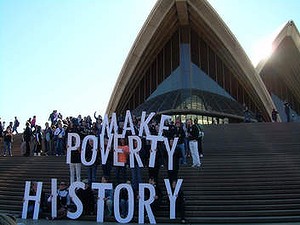


One other point which I think is important (and which we do cover in the paper) is that, once we include a control variable for Greens support in the regressions (both for support for ODA and donations), the negative association between religion and these types of support for aid disappears (it doesn’t become positive but ceases to be different from zero in a statistical sense).
To my mind this suggests that it is perhaps not religiosity per se that is negatively associated with support for ODA but rather a particular conservative type of religious belief, which is also strongly negatively associated with Green party support (quite a strong conservatism it should be noted, strong enough to not be positively associated with Coalition support on first preferences). At least that’s my thinking thus far, although I’d like to do some more work in this area.
Interesting although not surprising findings – consistent conclusion from all research on who gives and why is that giving is largely emotive, personal and a reflection of ones values.
Regarding religion, other research I’ve encountered cites that the more often someone attends religious services the more likely they are to donate to charity and donate larger amounts, so attendance at services would appear to be more a predictive factor than identification.
Potential explanations for the relationship with education includes: association with higher incomes; education draws people into memberships/communities of participation (e.g. professional associations, alumni) that can then bring about higher levels of solicitation; greater comprehension of social issues and needs.
Dear Justine,
Thank you very much for your comment.
On religion, as noted in my comment below, you may well be right on this (in the case of government ODA at least one other study finds frequent service attendees are more supportive, even if the religious as a whole are not.) Unfortunately, the census data we use don’t provide us with information on frequency of of attendance. This is a matter we hope to study more in the future.
On the education effect. Because we ran regressions controlling for income, we know education’s impact is not via income. However the other suggestions you make are very interesting and definitely worthy of further investigation. We will try our best to do this as we take the research forwards.
Thank you for your input.
Terence
Thanks Ben, in the interests of fairness I should note that Jono wrote most of the summary.
You’re right the religion finding is slightly puzzling. Note though, that it’s not just there for ODA but also for donations to NGOS. (Your explanation of ODA vs private donations on the other hand is, I think, very plausible for why we find a negative Coalition effect on support for ODA but not on NGO donations).
Possible explanations for the negative religious finding are:
1. Problems of ecological inference (a technical issue – discussed in the working paper, probably an unlikely explanation).
2. (For NGO donations) religious people giving in other ways (i.e. through tithes) rather than individual donations to ACFID members).
3. (For ODA) a certain type of religious person filling out the vote compas form in much higher numbers (and the difference being one not accounted for by weighting, which is unlikely).
4. The fact that our measure of religiosity is simply proportion of the electorate who told the census enumerator they were religious (all we could do with our data; although, note, we also got the same result when we replaced ‘religious’ with ‘christian’). Other work has found, for example, that frequent attenders of religious worship are more supportive of aid. So perhaps our result is being driven by the only-nominally-religious.
5. Some other data issue I haven’t thought of.
That said, the result seems pretty robust. So I think it’s real (even if I’m not yet certain). Like you I want to see a lot more testing, which is exactly what we hope to do in future work.
Thanks for your comment.
Useful summation and discussion – thanks.
On the matter of religiosity and ODA giving, it’s also possible that those who are regular service attendees give quite generously, but to NGOs that are not ACFID members and thus are not captured in your raw data. I’m thinking particularly of Compassion which – from my vague recollection (I know someone will correct me if I’m wrong) – is not an ACFID member because it chooses to use its work as a platform for proselytising… but, if included among the usual size and income rankings of NGOs, would be among the top few NGOs in the country.
Look forward to your further work on this topic.
Hi Michelle,
Thank you that is a very good point, or actually two good points in one..
1. On regular attendees of religious practice. Our data are census data and just tell us the proportion of the population who describe themselves as religious (or Christian – which we ran as an alternate model, getting the same results). As we discuss in the paper, the data give us nothing about frequency of attendance. And it is possible that patterns for regular attendance and associated giving might be different than those we see for people who are just nominally religious. Indeed, one oversees study has findings which suggest this is the case.
2. On the second point, about missing NGOs, we cover this a bit in the paper. It’s true that Compassion aren’t in the dataset, but nor are MSF, an equally large secular NGO. And we know that the NGOs in the dataset comprise a very large share of aid NGOs in Australia. And these facts, along with the fact we see the same negative correlation in surveyed support for government aid, suggest the finding is real. Although — for both of the reasons just discussed — I am very keen to test it using different data. Something we hope to do.
Thanks again.
Terence
Very interesting findings and great summary thanks Terence. It seems strange that religiosity has a negative impact on support for ODA. I would have thought the inverse to be true. Could it be that those who most closely align with a religion give more through their own charitable donations but don’t share the same positive view of ODA? Look forward to future research that might explain this result.